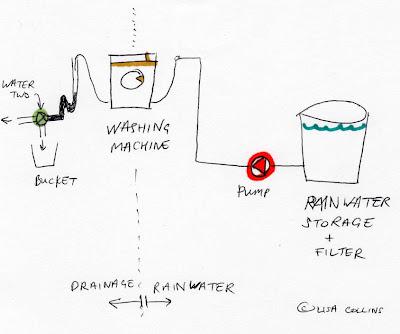
For World Water Day I am going to explain how to connect your washing machine to a rainwater tank, (see my previous post on how to set up a rainwater tank). In order to connect a washing machine to a rainwater tank, to make use of rain for washing clothes, a few things need to be considered first:
[1] Your washing machine is expecting water to be available at normal main network water pressure. If the water pressure is too low or the flow of water is too sluggish then the machine may fail to start. This can happen if your tank is too far away or the tank is nearly empty. This normal pressure varies widely, it depends where you live in relation to the network pumping station. In the UK it is commonly 1 to 3.5 bar, although it can be up to 10 bar. In continental Europe, water pressure above 3.5 bar is more common.
[2] The machine is intended to handle mains network water. This is high quality drinking standard water. However it is perfectly safe for rainwater to be used as a substitute for washing clothes providing that air pollution is not a major problem (acid rain and smog are no longer a problem in the UK) -and- that the collected water is well filtered to remove debris.
So in order to get water from your rainwater storage tank to the washing machine, you will probably need a pump. The exception to this is if the tank is higher than the washing machine, e.g. your tank is on the ground floor and your washing machine is in the basement. I recommend using a power shower booster pump for this purpose as these are fitted with a pressure sensor. The pump will automatically switch on when the washing machine starts and automatically switch off when the washing machine stops drawing water. This should provide adequate pressure to ensure the water flow reaches the washing machine. (The more bends and connections and the smaller the pipe diameter and the higher the washing machine, all increase the work load or pressure head demand on the pump).
These shower pumps are connected to the supply lines normally for both hot and cold connections. You will need to join the two inlets together so that they both accept cold rainwater. The same will need to be done to the two outlet lines, to create one out-going line.

The rainwater tank should include mesh filters to remove debris and an auto mains refill float valve (see my previous post on this). It is also possible to collect the drainage water expelled from the washing machine if you live in a particularly drought prone area. You can use this to:
[a] water the garden -make sure you use biodegradable soap
[b] reuse water from the second wash or rinse cycle to feed back into the first cycle of a second laundry load. This involves manually setting up a bucket to collect drainage water and manually pouring this into the rainwater storage tank for reuse. You will need to time the washing machine to work out how long this takes to finish each cycle, to get the hang of this. Most washing machines are designed to pump drainage water back up to worktop height to ensure the drainage water is properlly expelled from the machine, therefore the drain pipeline does not have to be at floor level to do its job.
Fitting a WATER TWO drainage valve in the drainage pipeline from the washing machine can be really useful for both of the above tasks.

